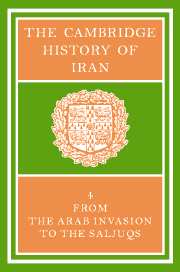Book contents
- Frontmatter
- 1 THE ARAB CONQUEST OF IRAN AND ITS AFTERMATH
- 2 THE ‘ABBĀSID CALIPHATE IN IRAN
- 3 THE ṬĀHIRIDS AND ṢAFFĀRIDS
- 4 The SĀMĀNIDS
- 5 THE EARLY GHAZNAVIDS
- 6 THE MINOR DYNASTIES OF NORTHERN IRAN
- 7 IRAN UNDER THE BŪYIDS
- 8 TRIBES, CITIES AND SOCIAL ORGANIZATION
- 9 THE VISUAL ARTS
- 10 NUMISMATICS
- 11 THE EXACT SCIENCES
- 12 LIFE SCIENCES, ALCHEMY AND MEDICINE
- 13(a) PHILOSOPHY AND COSMOLOGY
- (b) SŪFISM
- 14 THE RELIGIOUS SCIENCES
- 15 SECTS AND HERESIES
- 16 NĀSIR-I KHUSRAU AND IRANIAN ISMĀ‘ĪLĪSM
- 17 ZOROASTRIAN LITERATURE AFTER THE MUSLIM CONQUEST
- 18 ARABIC LITERATURE IN IRAN
- 19 THE RISE OF THE NEW PERSIAN LANGUAGE
- 20 (a) THE “RUBĀ'Ī” IN EARLY PERSIAN LITERATURE
- (b) ‘UMAR KHAYYĀM: ASTRONOMER, MATHEMATICIAN AND POET
- Bibliography
- Index
- Plate section
- Plate section">
- Map 1. Iran under the Abbasids">
- References
7 - IRAN UNDER THE BŪYIDS
Published online by Cambridge University Press: 28 March 2008
- Frontmatter
- 1 THE ARAB CONQUEST OF IRAN AND ITS AFTERMATH
- 2 THE ‘ABBĀSID CALIPHATE IN IRAN
- 3 THE ṬĀHIRIDS AND ṢAFFĀRIDS
- 4 The SĀMĀNIDS
- 5 THE EARLY GHAZNAVIDS
- 6 THE MINOR DYNASTIES OF NORTHERN IRAN
- 7 IRAN UNDER THE BŪYIDS
- 8 TRIBES, CITIES AND SOCIAL ORGANIZATION
- 9 THE VISUAL ARTS
- 10 NUMISMATICS
- 11 THE EXACT SCIENCES
- 12 LIFE SCIENCES, ALCHEMY AND MEDICINE
- 13(a) PHILOSOPHY AND COSMOLOGY
- (b) SŪFISM
- 14 THE RELIGIOUS SCIENCES
- 15 SECTS AND HERESIES
- 16 NĀSIR-I KHUSRAU AND IRANIAN ISMĀ‘ĪLĪSM
- 17 ZOROASTRIAN LITERATURE AFTER THE MUSLIM CONQUEST
- 18 ARABIC LITERATURE IN IRAN
- 19 THE RISE OF THE NEW PERSIAN LANGUAGE
- 20 (a) THE “RUBĀ'Ī” IN EARLY PERSIAN LITERATURE
- (b) ‘UMAR KHAYYĀM: ASTRONOMER, MATHEMATICIAN AND POET
- Bibliography
- Index
- Plate section
- Plate section">
- Map 1. Iran under the Abbasids">
- References
Summary
During the first decades of the 4th/10th century Iran was divided into three important spheres of power. The east (Transoxiana and Khurāsān) was subject to the Sāmānids, who also exerted a varying degree of authority over the provinces of Sīstān and Kirmān beyond the desert area of Dasht-i-Kavīr and Dasht-i-Lūt. The Iranian highlands by the Caspian Sea were controlled by the Zaidite rulers of Tabaristān and by various local potentates. In the south they were ruled by ‘Abbāsid governors directly dependent on Baghdad, whose constant ambition however was to establish themselves as independent dynastic rulers. The Sājids of Qazvīn had already succeeded in doing this by the end of the 3rd/9th century in Āzarbāījān in the northwest. The Zaidite rulers of Tabaristān and the other smaller princes joined the Sājids, though often involuntarily, to form a barrier effective enough to halt the westward progress of the Sāmānids. Iran's fate for the next hundred years was to be decided in the region on the south shore of the Caspian Sea, an area barely two hundred miles long and sixty miles wide. Within a few years an entirely new power was to emerge in this vacuum, the Būyids, who were able to wrest central and southern Iran from the ‘Abbāsids while the attention of the latter was being diverted by conflicts in Mesopotamia. Thus for the first time in Islamic history this area was released from the centralized control of Baghdad and united under the rule of an Iranian dynasty. In other words, the formation of native states, which had already been in progress for some time in eastern Iran, now began to take place in western Iran.
- Type
- Chapter
- Information
- The Cambridge History of Iran , pp. 250 - 304Publisher: Cambridge University PressPrint publication year: 1975
References
- 8
- Cited by



